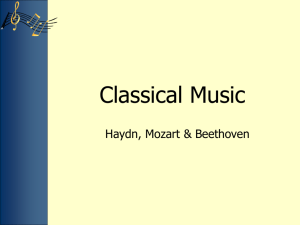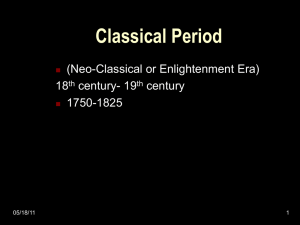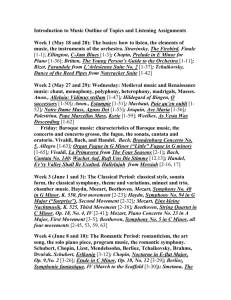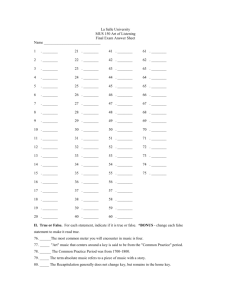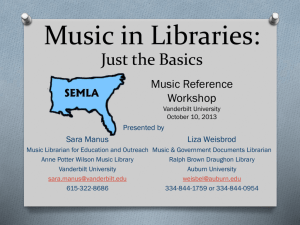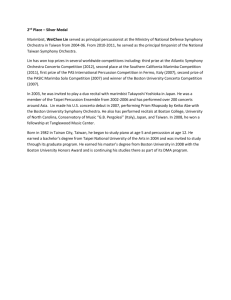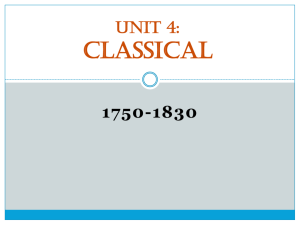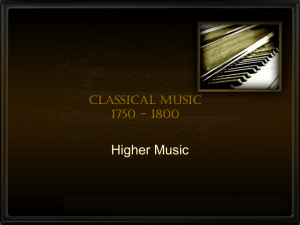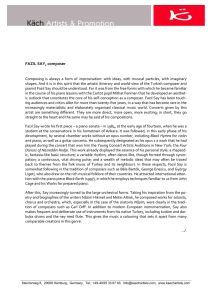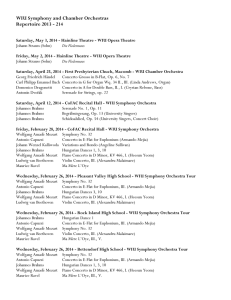Chapter 9: Classical Genres - MUS 231: Music in Western Civ
advertisement
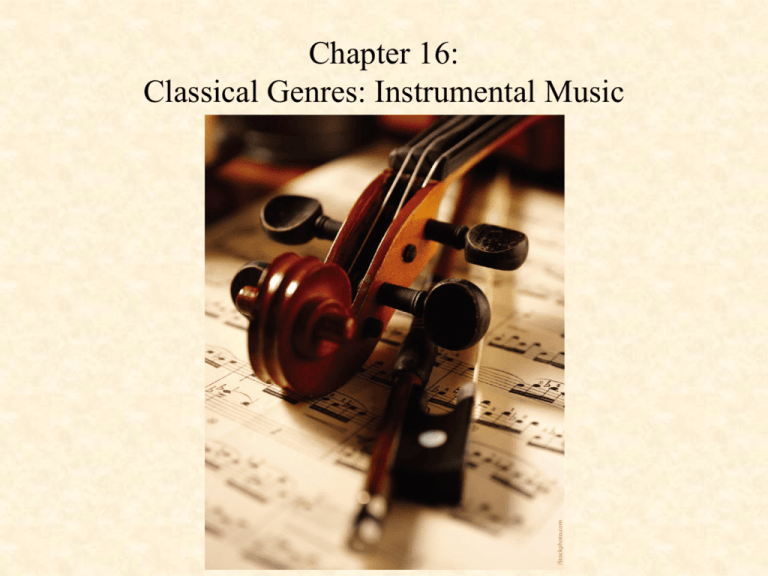
Chapter 16: Classical Genres: Instrumental Music The Symphony and the Symphony Orchestra • Symphony: A multimovement composition for orchestra lasting about 25 minutes in the Classical Era (nearly an hour in the Romantic Era) – Origins in the sinfonia – Baroque opera overture in three sections (fast – slow – fast) – Sections expanded into movements – By mid 1700’s, a fourth movement was added (Minuet) – Fast – Slow – Minuet – Fast – Increased in popularity as public concerts became more common – Created the terms symphony hall and symphony orchestra The Classical Symphony Orchestra • Increased in size as the symphony orchestra moved from private court to public auditorium • More wind instruments were added to increase variety and color Classical Orchestra Strings: 1st violins, 2nd violins, cellos, double basses (about 27 players total Woodwinds: 2 flutes, 2 oboes, 2 clarinets, 2 bassoons Brasses: 2 French horns, 2 trumpets (for festive pieces) Percussion: 2 timpani (for festive pieces) Mozart: Symphony No. 40 in G Minor (1788), K. 550 First Movement (Molto Allegro) p. 189 • Exposition: • Development: • Recapitulation: – Transition theme is extended – Brief coda Mozart: Symphony No. 40 • Second Movement: Andante – Slow, lyrical – Contrast between woodwind and the string timbre • Third Movement: Minuetto: Allegretto – Intense, somber mood • Fourth Movement: Allegro Assai – Sonata-allegro form – Begins with ascending rocket theme – Lack of transition into the recapitulation adds a feeling of urgency and acceleration The String Quartet • String Quartet: genre of chamber music – Created by Joseph Haydn – Goethe compared it to a conversation among four intelligent people • Two violins, viola, and cello • One player per part • Follows four movement form: fast – slow – minuet – fast • Performed by professionals and amateurs • Haydn and Mozart played together in a string quartet Haydn: Opus 76, No. 3, The “Emperor” Quartet (1797) Second movement, Poco adagio cantabile p.192 • Known as the “Emperor” because of its famous theme – Melody composed in response to military and political events – Honored Emperor Franz II – Tune served as national anthems for Austria and Germany – Used as a Protestant hymn – The Emperor’s Hymn was Haydn’s favorite composition • Theme and Variations form The Sonata • Genre of chamber music for solo piano or solo instrument accompanied by piano • More sonatas published in the 18th-century than any other genre • Three movement: fast – slow – fast • Performed by professionals and amateurs – Often used for piano students The Concerto • Large scale, multimovement work for instrumental soloist and orchestra intended for public audience • Virtuoso performers lured audiences to the concert hall • Three movements (no minuet) • Mozart: Wrote 23 piano concertos – Considered the father of the modern piano concerto – Often for his own performance Mozart: Piano Concerto in A major (1786), First movement Allegro p.196 • Piano and orchestra engage in a spirited give-and-take of the thematic material • Written for his student Barbara Ployer • Sonata-allegro form • Double exposition: The orchestra first introduces the first, second, and closing themes; Soloist then enters and plays the thematic material – Mozart introduces a new lyrical melody in the strings when we expect the second exposition to end • Cadenza Mozart: Piano Concerto in A major • Second Movement (Andante): – Exquisitely crafted lines and coloristic harmonies – Daring harmonic changes – At once sublimely beautiful and distantly remote • Third Movement (Presto) – Boisterous rondo – Banter back and forth between soloist and orchestra
